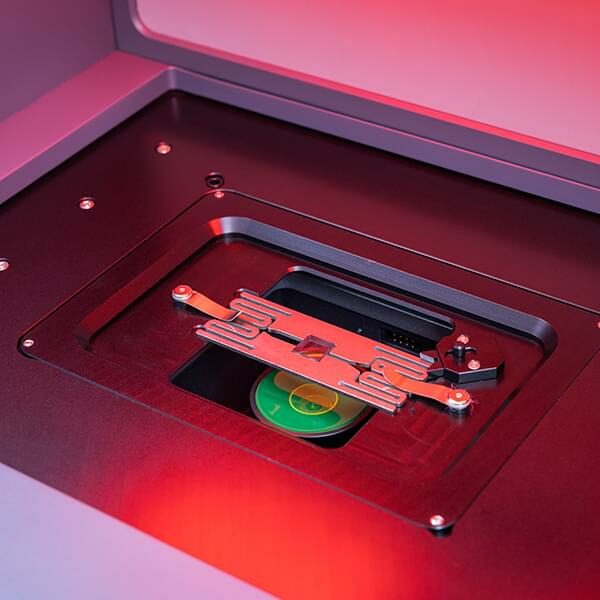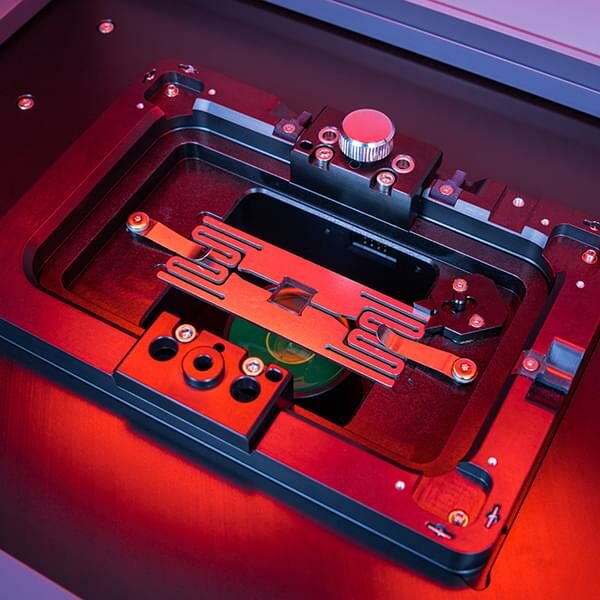
Where precision meets economic efficiency
NanoOne is the fastest high-resolution 3D printing system on the market. It is based on multiphoton lithography and combines the precision of 2-photon polymerization with an unmatched throughput of >450 mm³ per hour. This makes the system suitable not only for scientific research approaches and multi-user facilities but also for the batch and small series production of industrially applied microparts.
Powerful
versatility ...
Minimal horizontal feature size ≥170 nm
Minimal vertical feature size ≥550 nm
Minimal surface roughness ≤10 nm
Throughput
>450 mm³/h
Writing speed ≥1000 mm/s
Accessible writing area 100x120 mm
Part height up to 40 mm
Printing with living cells
Batch and small series production
Desktop system
Based on a galvanometer scanner
… for an unlimited range of applications
Microoptics
Micromechanics
Microfluidics
Medical engineering
Surface elements
Filter elements
Small
High-resolution desktop printing system with sub-micrometer resolution
Not only are the achievable structural details of ≥170 nm small, also the printing system itself has a small footprint. With external dimensions of 58.5 x 71 x 65 cm³, the NanoOne system fits not only into industrial production halls but also into the narrowest lab facility.
Fast
Up to a 100 times higher throughput for economically relevant production cycles
The patented printing process of UpNano combines highest resolution with unmatched performance for the first time. Scan speeds of ≥1000 mm/s and throughput rates of >450 mm³/h enable prototyping as well as batch and series production.
Powerful
High power laser for mesoscale fabrication and biological applications
With up to 1 W, the laser source of the NanoOne system is very powerful, enabling the use of low magnification objectives and thus the production of mesoscale parts. Despite the high power, the laser wavelength has low absorption in cells and enables cell, tissue and bioprinting approaches.
The right upgrade for every application
NanoOne printing systems are always offered in a ready-to-use standard configuration but can also be customized with additional modules to meet specific customer requirements. These modules can also be retrofitted at any later time.
Unmatched throughput
for batch and series production
The NanoOne printing system once and for all puts an end to the thinking that "2PP printing is meant to be slow". The innovative and patented printing process makes it possible not only to produce microcomponents with the usual high resolution and structural details in the range of 170 nm, but also to take the step towards batch and series production.
Within one print job, the NanoOne system can print a series of components that are either identical or differ in design and/or printing parameters. With just a few clicks, the desired parameters can be assigned to the components. Alternatively, the predefined and proven print profiles can be used.
The enormous performance of the system also makes it possible for the first time to produce components in the centimeter range. With a possible component height of up to 40 mm, the NanoOne system closes the gap between conventional 2PP printing systems and microstereolithography. And it does so with extraordinary speed.
The powerful laser that can be built into the NanoOne system allows the use of low magnification objectives and thus the production of unexpectedly large structures with structure details of less than 2 microns. The solution for components in the sweet spot between classic 2PP and microstereolithography applications.

Clean even without a clean room
In the production of micro and nanoscale, a clean working environment with a low level of particles is an absolute must. That's why the NanoOne printing systems are equipped with an H14 HEPA filter by default.
When loading and unloading the NanoOne system, clean room class ISO7 can be maintained. In the closed state, during the printing process, no particles >0.3 micrometers are detectable. This means that low-contamination loading and unloading and contamination-free printing is possible even without a clean room.

Compensation of substrate tilt
The tilt of the substrate is determined using the autofocus function and compensated by means of the tilt frame. Another element to meet the requirements of highest precision. The substrate tilt compensation enables the reproducible production of large and/or thin structures with the NanoOne printing system.
The tilt frame can be used with standard glass substrates as well as with special holder systems for printing on glass fiber and ferrule as well as wafer.
Batch of 35 ISO tensile test specimens for material characterization
18x18 array of cell scaffolds with a diameter of 1 mm
Complex optical setups produced with one printing system

